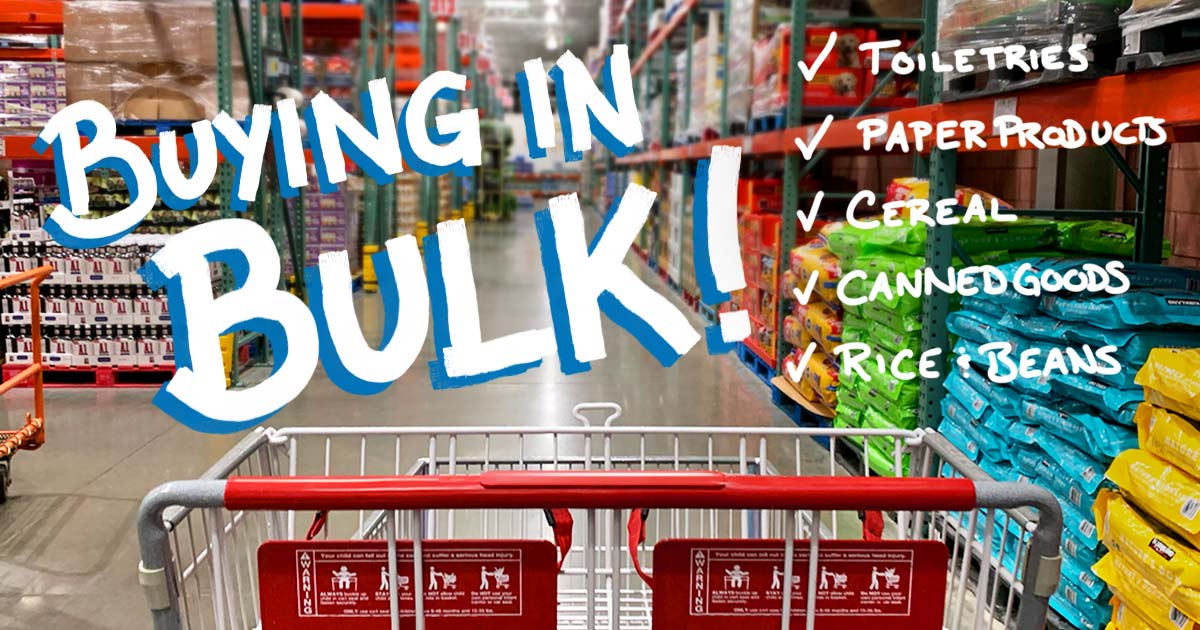Understanding the Benefits of Buying in Bulk
Purchasing products in bulk can be a cost-effective and convenient way to stock up on essentials. By buying in bulk, individuals can save money on their favorite products, reduce waste, and enjoy increased convenience. For instance, buying non-perishable food items, household supplies, and personal care products in bulk can lead to significant cost savings over time.
One of the primary advantages of buying in bulk is the potential for substantial cost savings. When purchasing products in large quantities, the cost per unit is often lower than buying smaller quantities. This can result in significant savings, especially for products that are used frequently. Additionally, buying in bulk can help reduce waste by minimizing packaging and reducing the number of trips to the store.
Another benefit of buying in bulk is increased convenience. With a bulk purchase, individuals can stock up on their favorite products and avoid frequent trips to the store. This can be especially useful for busy households or individuals with limited mobility. Furthermore, buying in bulk can provide peace of mind, knowing that essential products are always on hand.
However, it’s essential to note that buying in bulk may not always be the best option. Some products, such as perishable items, may not be suitable for bulk purchase due to limited shelf life. In such cases, buying in bulk can lead to waste and unnecessary expenses. Therefore, it’s crucial to carefully consider the pros and cons of buying in bulk before making a purchase.
For those looking to explore the benefits of buying in bulk, there are several options available. Online retailers, wholesale clubs, and local discount stores offer a wide range of products in bulk, making it easy to find the best deals. By understanding the benefits of buying in bulk and making informed purchasing decisions, individuals can save money, reduce waste, and enjoy increased convenience.
Identifying the Right Products for Bulk Purchase
When it comes to buying products in bulk, it’s essential to identify the right products that meet your needs and provide the best value. To determine which products are suitable for bulk purchase, consider factors such as shelf life, storage space, and personal consumption rates.
Shelf life is a critical factor to consider when buying in bulk. Perishable items, such as meat, dairy products, and baked goods, may not be the best candidates for bulk purchase due to their limited shelf life. On the other hand, non-perishable items, such as canned goods, pasta, and rice, can be purchased in bulk without worrying about spoilage.
Storage space is another important consideration when buying in bulk. Make sure you have enough space to store the bulk purchase, and consider the size and weight of the products. For example, buying a large quantity of bottled water may not be practical if you have limited storage space.
Personal consumption rates are also crucial when determining which products to buy in bulk. Consider how often you use a particular product and how long it takes to consume it. For instance, if you use a lot of coffee or tea, buying a large quantity may be a good idea. However, if you only use a small amount, it may be better to buy in smaller quantities.
To ensure quality and satisfaction, research products and read reviews before making a bulk purchase. Look for products with good reviews and ratings, and check the manufacturer’s reputation. You can also check the product’s ingredients, nutritional content, and packaging to ensure it meets your standards.
Some popular products that are commonly purchased in bulk include:
- Non-perishable food items, such as canned goods, pasta, and rice
- Household supplies, such as cleaning products, paper towels, and toilet paper
- Personal care products, such as shampoo, conditioner, and body wash
- Pet food and supplies
- Office supplies, such as paper, pens, and printer ink
By considering these factors and researching products, you can make informed decisions when buying products in bulk and ensure that you get the best value for your money.
Where to Buy Products in Bulk: Online and Offline Options
When it comes to buying products in bulk, there are various options available, both online and offline. Each option has its pros and cons, and it’s essential to consider these factors when deciding where to make your bulk purchase.
Online retailers such as Amazon and Walmart offer a wide range of products in bulk, often with free shipping and competitive pricing. These retailers also provide customer reviews and ratings, making it easier to research and compare products. Additionally, online retailers often have a wider selection of products than physical stores, making it easier to find what you need.
Wholesale clubs like Costco and Sam’s Club are another popular option for buying products in bulk. These clubs offer a wide range of products, including fresh produce, meat, and household essentials, at discounted prices. However, membership fees can be a drawback, and the selection of products may be limited compared to online retailers.
Local discount stores and dollar stores are also great options for buying products in bulk. These stores often carry a limited selection of products, but at deeply discounted prices. Additionally, shopping at local stores can help support the local economy and reduce carbon emissions from transportation.
Other options for buying products in bulk include:
- Specialty stores, such as pet stores or office supply stores, that offer bulk discounts on specific products
- Manufacturer’s websites, which may offer bulk discounts on their products
- Local farmers’ markets or co-ops, which may offer bulk discounts on fresh produce and other products
When shopping for bulk products, it’s essential to consider the pros and cons of each option and choose the one that best meets your needs. By doing your research and comparing prices, you can find the best deals and make the most of your bulk purchase.
Some popular bulk-buying destinations include:
- Amazon’s Warehouse Deals, which offers discounted prices on bulk purchases
- Costco’s bulk section, which offers discounted prices on a wide range of products
- Sam’s Club’s bulk section, which offers discounted prices on a wide range of products
- Local discount stores, such as Aldi or Lidl, which offer discounted prices on bulk purchases
By considering these options and doing your research, you can find the best deals and make the most of your bulk purchase.
How to Calculate the Best Bulk Purchase Quantity
Calculating the optimal bulk purchase quantity is crucial to avoid waste and save money. To determine the best quantity, consider the following factors: personal consumption rates, storage space, and product shelf life.
Start by calculating your personal consumption rate for the product. This can be done by tracking how much of the product you use over a certain period of time. For example, if you use 2 pounds of coffee per week, you can calculate your monthly consumption rate as 8 pounds (2 pounds/week x 4 weeks/month).
Next, consider the storage space available for the bulk purchase. Make sure you have enough space to store the product without overcrowding or compromising the product’s quality. For example, if you’re buying bulk coffee, you’ll need to ensure you have enough storage space for the coffee beans or grounds.
Finally, consider the product’s shelf life. If the product has a limited shelf life, it’s essential to calculate the optimal quantity to avoid waste. For example, if you’re buying bulk perishable items like meat or dairy products, you’ll need to ensure you can consume them before they expire.
Using these factors, you can calculate the optimal bulk purchase quantity using the following formula:
Optimal Quantity = (Personal Consumption Rate x Storage Space) / Product Shelf Life
For example, if your personal consumption rate for coffee is 8 pounds/month, you have 10 pounds of storage space available, and the coffee beans have a shelf life of 6 months, the optimal quantity would be:
Optimal Quantity = (8 pounds/month x 10 pounds) / 6 months = 13.33 pounds
Round down to the nearest whole number to avoid overbuying, so the optimal quantity would be 13 pounds.
By calculating the optimal bulk purchase quantity, you can avoid waste, save money, and ensure you have a steady supply of your favorite products.
Tips for Storing and Managing Bulk Purchases
Once you’ve made your bulk purchase, it’s essential to store and manage your products effectively to maintain their quality and extend their shelf life. Here are some tips for storing and managing bulk purchases:
Organize your storage space: Before storing your bulk purchases, make sure you have a dedicated storage space that is clean, dry, and well-ventilated. Consider using shelves, bins, or containers to keep your products organized and easy to access.
Use airtight containers: Airtight containers are perfect for storing bulk purchases like coffee, nuts, or grains. They keep the products fresh and prevent moisture, air, or pests from getting in.
Label and date your products: Labeling and dating your products can help you keep track of what you have and how long it’s been stored. This can also help you identify products that are near their expiration date or need to be used up quickly.
Keep track of inventory: Keeping track of your inventory can help you avoid overbuying or running out of products. Consider using a spreadsheet or inventory management tool to keep track of your products and their quantities.
Store products in a cool, dry place: Many bulk purchases, such as canned goods or cleaning supplies, can be stored in a cool, dry place like a pantry or cupboard. Avoid storing products in direct sunlight, near heat sources, or in humid environments.
Consider using storage solutions: There are many storage solutions available that can help you manage your bulk purchases, such as stackable containers, baskets, or shelves. Consider investing in these solutions to keep your products organized and easy to access.
Some popular storage solutions for bulk purchases include:
- Stackable containers: These are perfect for storing bulk purchases like canned goods, cleaning supplies, or personal care products.
- Baskets: Baskets are great for storing bulk purchases like fruits, vegetables, or nuts.
- Shelves: Shelves are perfect for storing bulk purchases like books, kitchen utensils, or cleaning supplies.
By following these tips, you can effectively store and manage your bulk purchases, maintain their quality, and extend their shelf life.
Avoiding Common Pitfalls of Bulk Buying
While buying products in bulk can be a great way to save money and reduce waste, there are some common pitfalls to avoid. Here are some common mistakes to watch out for:
Purchasing too much of a perishable item: When buying in bulk, it’s essential to consider the shelf life of the product. Purchasing too much of a perishable item can lead to waste and unnecessary expenses.
Neglecting to check expiration dates: Always check the expiration dates of products before buying in bulk. This can help you avoid purchasing products that are near their expiration date or have already expired.
Failing to consider storage space: Before buying in bulk, make sure you have enough storage space for the products. Failing to consider storage space can lead to clutter and disorganization.
Not researching products: Researching products before buying in bulk can help you ensure that you’re getting the best quality products at the best price. Always read reviews and check the product’s ingredients and materials.
Not considering personal consumption rates: When buying in bulk, it’s essential to consider your personal consumption rates. Purchasing too much of a product can lead to waste and unnecessary expenses.
To avoid these common pitfalls, consider the following strategies:
- Start small: When buying in bulk for the first time, start with a small quantity to ensure that you can consume the product before it expires.
- Check expiration dates: Always check the expiration dates of products before buying in bulk.
- Research products: Research products before buying in bulk to ensure that you’re getting the best quality products at the best price.
- Consider storage space: Before buying in bulk, make sure you have enough storage space for the products.
- Plan ahead: Plan ahead and consider your personal consumption rates before buying in bulk.
By avoiding these common pitfalls, you can make the most of buying products in bulk and save money, reduce waste, and increase convenience.
Maximizing Savings with Bulk Buying Strategies
Buying products in bulk can be a great way to save money, but there are also several strategies that can help maximize savings. Here are some tips for maximizing savings with bulk buying:
Buy in bulk with friends or family: Buying in bulk with friends or family can help split the cost and make it more affordable. This can be especially helpful for expensive or bulkier items.
Use cashback apps: Cashback apps like Ibotta, Fetch Rewards, and Rakuten offer cashback on certain bulk purchases. These apps can help you earn money back on your bulk purchases and maximize your savings.
Take advantage of sales and discounts: Keep an eye out for sales and discounts on bulk purchases. Many retailers offer discounts on bulk purchases, especially during holiday seasons or special events.
Use coupons and promo codes: Coupons and promo codes can also help you save money on bulk purchases. Look for coupons and promo codes online or sign up for newsletters to receive exclusive offers.
Consider buying in bulk during off-peak seasons: Buying in bulk during off-peak seasons can help you save money. Many retailers offer discounts on bulk purchases during off-peak seasons to clear out inventory.
Use price comparison tools: Price comparison tools like PriceGrabber or NexTag can help you compare prices on bulk purchases. These tools can help you find the best deals and maximize your savings.
Some popular bulk-buying strategies include:
- Buying in bulk with friends or family
- Using cashback apps
- Taking advantage of sales and discounts
- Using coupons and promo codes
- Buying in bulk during off-peak seasons
- Using price comparison tools
By using these strategies, you can maximize your savings and make the most of buying products in bulk.
Conclusion: Making the Most of Bulk Buying
In conclusion, buying products in bulk can be a great way to save money, reduce waste, and increase convenience. However, it’s essential to approach bulk buying with careful planning, research, and strategy to maximize the benefits.
By understanding the benefits of buying in bulk, identifying the right products for bulk purchase, and knowing where to buy products in bulk, you can make informed decisions and avoid common pitfalls.
Additionally, calculating the best bulk purchase quantity, storing and managing bulk purchases effectively, and maximizing savings with bulk buying strategies can help you get the most out of your bulk buying experience.
Whether you’re a seasoned bulk buyer or just starting out, the key to success lies in being intentional and strategic in your approach. By following the tips and guidelines outlined in this article, you can make the most of bulk buying and start enjoying the benefits of purchasing in quantity.
So, start exploring bulk-buying options today and discover the convenience, cost savings, and reduced waste that come with buying products in bulk.







